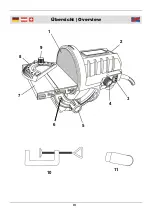
12
Operation
Before first Use
Remove the sander and all accessories out of the packaging and check all
parts for damage in transit. Keep packaging materials out of reach of children.
There is risk of suffocation!
Intended Use
The sander may only be used for dry sanding work. This sander is well suited
for fine sanding work and for making minor material corrections. Materials that
may be sanded with this sander include all types of wood, steel, non-ferrous
and precious metals, plastics, acrylic glass and fiberglass.
Attention:
After 15 minutes of operation allow the saw to cool down for at
least 10 minutes.
Selecting the Sanding Paper
Always use abrasive papers suited to the material you want to sand. The
papers must have the correct grain size.
Depending on grain size there are degrees of coarseness. The
coarseness is specified by a number on the back of the papers. The higher
the number is, the finer the grain.
It is important to use the right paper for each job. For rough sanding use
grain size 60, for soft wood as larch, pine or spruce use paper with grain
size 80. For dense hardwood as beech or maple, grain sizes 120 can be
used.
Clamping the Sander to a Workbench
Before use the sander must be securely clamped to a workbench or similar
stable surface. The sander may be clamped in a vertical position (Fig. 1) or in
its normal horizontal position (Fig. 2).
Fig. 1
Fig. 2
10
A
B
Содержание 90 00 83
Страница 3: ...III Übersicht Overview 1 2 5 6 7 8 9 3 4 10 11 ...
Страница 23: ...19 Notizen Notes ...
Страница 24: ...20 Notizen Notes ...











































